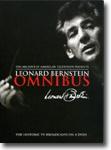 |
|
|||||||||||||||||||||||||||||||||||||||||||||||||||||||||||||
Leonard Bernstein, early mass media star, gave millions of people a long string of sophisticated lessons in music. Throughout the 1950s and '60s, Bernstein appeared on all three major television networks many times as brilliant educator and glorious composer, all the while and just off screen he was also a glamorous bon vivant. Bernstein was a man who lived large and looms large still in the musical consciousness of the United States, and the world as well. From 1958 to 1973, Bernstein delivered four TV music performance/lectures per year, illustrated lavishly with the likes of the New York Philharmonic: the Young People's Concerts Bernstein posed his viewers questions: what made a certain composer tick, what is it about this piece of music that so captivates and moves us, what makes opera grand? He then proceeded with confident charm, humor and generous intelligence to systemically answer them. Bernstein broke things down, created formal, patterned structures out of music that he could communicate in discrete bits that accreted and formed whole lessons - if you could stay with him all the way. But even if you couldn't, Bernstein's knack for breaking out and illustrating the structural bits - the rhythmic beams beneath our feet and they buttresses of melody soaring above our heads, he might say - meant that most people could grasp enough of a handle on him to gasp right along with him at the wondrously complex simplicity of the music all around us. Bernstein made even opera sound good, while his programs on modern art music, musical comedy and jazz are sonically radiant and pedagogically masterful productions. In the almost 8 hours of TV on these four DVDs, Bernstein goes deep and wide through a variety of musical forms, all of them involving large numbers of players, singers and actors in need of collective direction under the will of a maestro. There's definitely a bias toward Western European art music with Bernstein, but he also rocked with popular culture. That bona vide had been laid down early on with his 1949 hit, West Side Story Leonard Bernstein was the Walter Cronkite of classical music TV. He covered classical and modern musics in a fair and balanced way, was accessible, and made you feel smart. He was strikingly easy on the eyes and moved like both a dancer and like he was a good fuck and knew it. In places where Cronkite had to worry about his reputation, Bernstein, being a musician, an artist, was freer. And so, over the years, a mystique grew up around Bernstein: he was a giant living among us; he brought the great halls of Manhattan into his viewers' living rooms. He befriended his audience's children - I was one of those children - and coaxed our minds to scale big ideas, to hear voices and ideas in the structure of a symphony, to fill our lungs with the narrative wave of a musical or do a kind of ecstatic shimmy while listening to the mathematical story ticking inside a piece by J.S. Bach. A Bernstein show was never over when it was over: he deliberately and with aforethought incited riots of curiosity. He burned with an inner flame and he stoked the ego, suggesting that you could gain mastery of music if you followed his example. In 1955's "The Art of Conducting," he hands over the keys to his kingdom, describes the path to his very door - but you'd better start practicing now if you were ever going to be as good as he is, to reach his castle and take charge of the keys. |
|
|||||||||||||||||||||||||||||||||||||||||||||||||||||||||||||
|
||||||||||||||||||||||||||||||||||||||||||||||||||||||||||||||
| action | animation | art house/international | comedy | documentary | drama | family | horror/sci-fi | suspense | television | ||||||||||||||||||||||||||||||||||||||||||||||||||||||||||||||
| contact | home | ||||||||||||||||||||||||||||||||||||||||||||||||||||||||||||||


